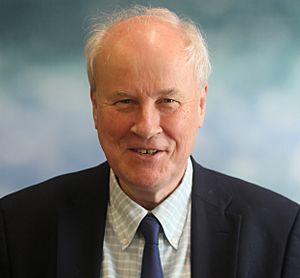R. Keith Ellis facts for kids
Quick facts for kids
R. Keith Ellis
|
|
|---|---|

Ellis in 2019
|
|
| Born |
Richard Keith Ellis
17 November 1949 Aberdeen, Scotland
|
| Alma mater | |
| Known for |
|
| Awards |
|
| Scientific career | |
| Institutions | University of Durham |
| Doctoral advisors | Guido Altarelli Luciano Maiani |
Richard Keith Ellis, born on November 17, 1949, is a famous British scientist. He is a theoretical physicist, which means he uses math and ideas to understand how the universe works. He works at the University of Durham in the UK.
Professor Ellis is a top expert in a field called Quantum Chromodynamics. This is the theory that describes the strong force, which holds tiny particles together. He also studies how particles behave in giant machines called colliders.
Contents
Early Life and Education
Richard Keith Ellis studied at the University of Oxford. He earned his first degree in 1971 and a higher degree in 1974. After his studies, he worked at many important science centers around the world.
These places included Imperial College in London and MIT in the United States. He also worked at Caltech, CERN in Switzerland, and the University of Rome in Italy.
His Work in Physics
In 1984, Professor Ellis joined Fermilab, a big particle physics lab in the US. He became the head of their Theoretical Physics Department in 1993. He led the department for over ten years, until 2004.
Later, in 2015, he moved back to the UK. He became a physics professor at the University of Durham. He also directed the Institute for Particle Physics Phenomenology there until 2019.
Understanding Particle Collisions
Professor Ellis's work is very important for studying tiny particles. These particles are smashed together in powerful machines called colliders. Famous colliders include the Tevatron at Fermilab and the Large Hadron Collider at CERN.
His research helps scientists understand what happens when particles collide at very high energies. He has helped interpret the results from many experiments. This means he helps explain what the data from these collisions tells us.
Key Discoveries and Calculations
Professor Ellis made a big contribution by calculating how jets of particles form. He did this with Douglas Ross and Tony Terrano. This work helped scientists figure out the strength of the strong coupling, a fundamental force.
He also worked with Guido Altarelli and Guido Martinelli on another important calculation. They studied how lepton pairs are produced. Their work helped match what scientists observed with what the theories predicted.
Professor Ellis has also written many important papers about heavy quark production. Quarks are tiny building blocks of matter. He also helped create a computer program called MCFM. This program helps scientists simulate particle collisions.
In 1996, Professor Ellis co-authored a book about QCD and collider physics. He wrote it with W. J. Stirling and B. R. Webber. This book is widely used by other physicists.
Awards and Recognition
Professor Ellis has received many honors for his amazing work. In 1988, he was made a Fellow of the American Physical Society. This is a special recognition from a leading physics organization.
In 2009, he became a Fellow of the Royal Society of London. This is one of the oldest and most respected scientific honors in the world.
Also in 2009, he won the J. J. Sakurai Prize for Theoretical Particle Physics. He shared this award with John Collins and Davison Soper. They won for their work in perturbative Quantum Chromodynamics. Their research was crucial for understanding high-energy particle collisions.
In 2019, he received the Paul Dirac Medal from the Institute of Physics. He was honored for his important work in quantum chromodynamics (QCD). His calculations were key to showing that QCD is the correct theory for the strong interaction.

